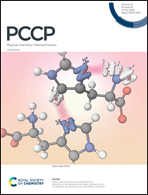An insight into the thermo-thickening behavior of wormlike micellar solutions based on ultra-long-chain surfactants†
Abstract
Generally, the solution viscosity of wormlike micelles (WLMs) assembled from common surfactants decreases upon an increase in the temperature, following the Arrhenius law. However, abnormal thermo-thickening behavior has been repeatedly observed for WLMs formed by ultra-long-chain (≥C18) surfactants. It would be useful to unravel the mechanism behind this phenomenon. Here, three C22-tailed surfactants with an erucyl tail, two of them containing carboxylate or sulfonate head groups (UC22DAB and UC22DAS) and a cationic one with an iodide counterion (UC22DAI), and two C18-tailed betaines with olemido- and stearamidopropyl hydrophobic chains (UC18DAS and C18DAS) were characterised in terms of their viscosity and viscoelastic behavior with increasing temperature to examine the roles of head groups, tail length and tail nature. Their micellar structures were elucidated at various temperatures using small angle neutron scattering (SANS), small angle neutron X-ray scattering (SAXS) and molecular dynamics simulation. It is found that the thermo-thickening behavior of ultra-long-chain surfactants is ascribed to the prolonged persistence length and increased entanglement points. When the temperature is increased, an increase in viscosity is always accompanied by a longer persistent length, thus a larger hydrodynamic volume. The iceberg structure around the hydrophobic tail of surfactants can be destroyed at high temperatures leading to the self-assembly of these surfactants. In this self-assembly process, compared to cationic surfactants, zwitterionic surfactants can form WLMs more readily due to weak electrostatic repulsions between their head groups; the longer tails give the surfactants enhanced hydrophobicity to form WLMs with a long breaking time; the cis-unsaturation and the resulting kink in the hydrophobic tails give the surfactants good solubility, which is not conducive to the formation of micelles. In brief, the zwitterionic, longer tail and saturated tail surfactants can form WLMs with a prolonged persistence length at elevated temperatures.



 Please wait while we load your content...
Please wait while we load your content...